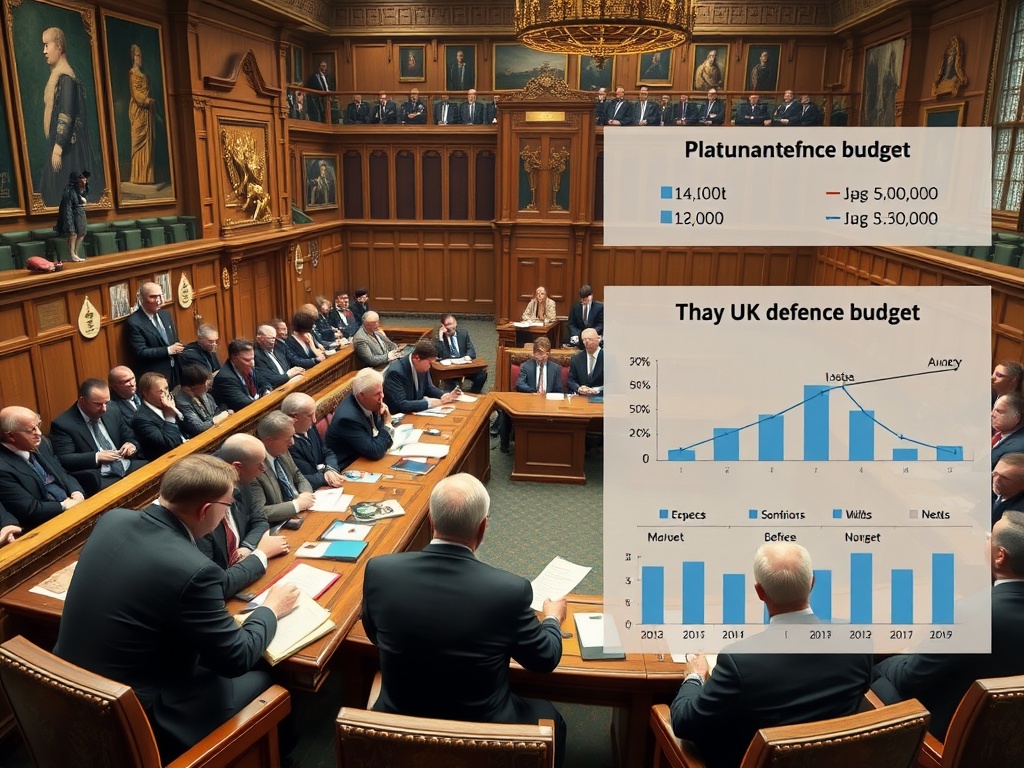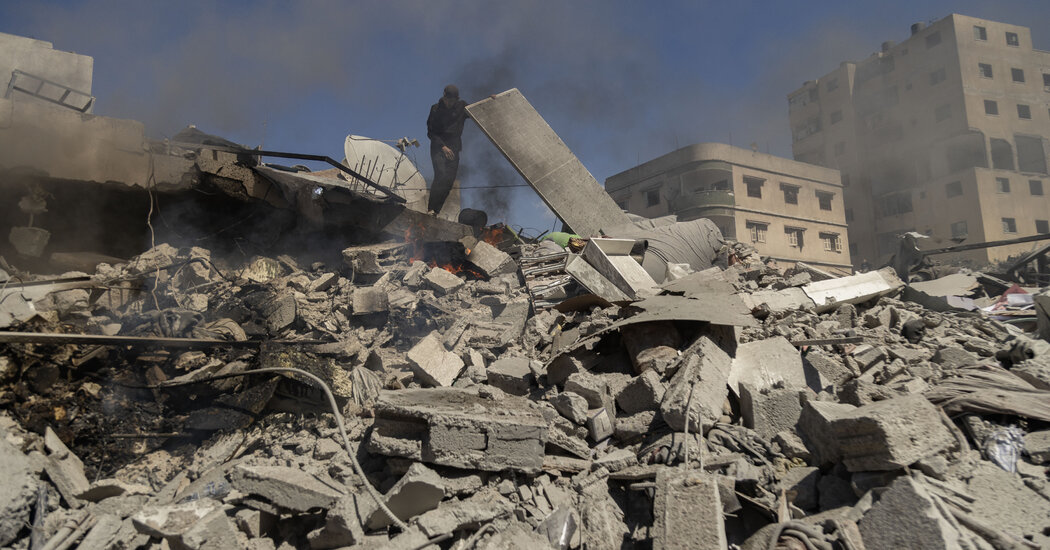Defence Budget Debate: A Complex Challenge for the UK
Downing Street and the Treasury appear to be engaged in a contentious debate regarding the timing and extent of increases to the UK’s defence budget. However, this debate is merely a surface-level conflict that masks a far more intricate challenge: reconciling the UK’s myriad military needs and obligations. The pressing task of strengthening Ukraine’s military capabilities in the face of Russia’s relentless aggression is paramount. Additionally, there is the growing recognition that the UK will eventually need a ballistic missile defence system to safeguard its territory. The government and military leaders face a monumental task in ensuring the nation’s security amidst these competing demands.
The UK currently allocates approximately 2.3% of its GDP to defence—equivalent to around £56.9 billion for the current financial year—making it one of the highest spenders in Europe. However, this figure falls short of the 2.5% target pledged by the Labour Party, which has yet to outline a specific timeline for achieving this commitment. Furthermore, defence chiefs have reportedly expressed a desire for the government to commit to a figure of 2.65%, which is still significantly lower than the 5% GDP figure suggested by former President Trump as the United States begins to transition away from its long-standing role in European defence.
There is a growing consensus that even if the UK government were to reach the 2.65% target, it would not be sufficient for a military that, despite its global reputation, is in dire need of replenishment after years of cuts. Estimates suggest that for the UK to meet its NATO obligation of deploying a fully operational warfighting division of approximately 30,000 personnel could take up to a decade.
Support for Ukraine: A Priority for NATO
As Ukraine braces for its third year of conflict with Russia, its support remains a top priority for the UK and its NATO allies, despite Trump’s inclination to negotiate with Putin. Successive UK prime ministers have asserted that the battlefields of Donetsk and beyond represent the frontline in a broader struggle for European security against a Russian regime that is unlikely to halt its ambitions at merely subjugating Ukraine. As Dr. Jack Watling, a warfare expert at the Royal United Services Institute (RUSI), stated in a recent study, “Continuing to support Ukraine to bring about a sustainable peace should be the foremost priority of European NATO, as it reduces the threat to Europe and the likelihood that Europe will have to engage in future conflicts.” He emphasizes that a sustainable peace requires deterring Russia from resuming hostilities.
Arming Ukraine: A Necessity for Deterrence
The key to achieving such deterrence lies in ensuring that Ukraine has access to the necessary armaments to confront Russia. To date, the UK has supplied around £7.8 billion in military aid to Kyiv. However, experts claim that a continuous flow of weaponry is crucial for Ukraine to negotiate from a position of strength with Putin. Dr. Watling and his colleague, Nick Reynolds, highlight the importance of supplying long-range missile capabilities to strike Russian bases and facilities that launch assaults on Ukrainian troops.
Britain and France have recently authorized the use of Storm Shadow or Scalp cruise missiles against targets on Russian soil, which are capable of penetrating fortified installations. The need for sustained supplies is further underscored by the psychological and physical damage inflicted by Russia’s air force, which employs glide bombs—conventional heavy munitions fitted with satellite guidance to strike targets with alarming precision. Currently, Ukrainian forces lack adequate protection against this tactic, making it imperative to disrupt Russian air force bases using long-range missiles.
However, this is just one of many urgent needs identified by RUSI. Ukraine also requires a consistent supply of artillery shells and barrels, financial backing for drone production, automated turrets for tanks and fighting vehicles to enhance attack accuracy, and support for constructing robust defensive lines with extensive subterranean networks for troop withdrawals if current frontlines are breached. The challenge is compounded by the need to replenish dwindling stockpiles of donated weaponry, with estimates suggesting that the UK’s cost to replace the equipment sent to Kyiv has soared to approximately £2 billion annually.
The Personnel Challenge: Peacekeeping and Beyond
A significant issue facing the UK’s defence capabilities is the availability of personnel to fulfil commitments and effectively utilize existing technology. As one former commander articulated, “There is absolutely no point in having the best destroyers, missile systems, early-warning aircraft, and tanks if we don’t have the trained individuals to operate them.” This shortfall is particularly evident when considering the UK’s potential contribution to an international peacekeeping force if a deal is reached to end the conflict in Ukraine. With Trump seemingly ruling out American participation, the responsibility falls to European nations, and Labour leader Keir Starmer has suggested that the UK could deploy around 100,000 troops if a long-term agreement is established.
However, serious doubts remain about the UK’s ability to meet such commitments. General Lord Dannatt, former head of the British Army, recently cautioned that the UK risks “embarrassment” if required to support Ukraine’s post-war stability. He stated on BBC Radio 4’s *The Week in Westminster*, “It would probably require about 100,000 personnel. The UK would need to contribute a significant proportion of that. Currently, our military is so depleted in terms of numbers and capabilities that it could be quite embarrassing.”
National and European Security: A Neglected Priority
The UK’s capacity to defend itself begins with securing its territory and seas, as well as projecting force alongside key European allies. Many argue that this fundamental task has been neglected to a degree that poses a serious threat to national security.
Assessment of Defence Readiness

In late 2022, the House of Lords defence committee delivered a stark assessment of the UK’s military readiness, revealing that the armed forces would exhaust their ammunition “in a few days” if called to engage in combat. The Royal Air Force lacks the capability to defend the UK’s airspace against the level of missile and drone assaults now commonly faced by Ukraine. Furthermore, it could take five to ten years for the Army to mobilize a battle-ready division of 25,000 to 30,000 troops equipped with the requisite tanks, artillery, and helicopters. This alarming evaluation followed an American general’s critique that the UK can no longer be relied upon to contribute a “tier one” military alongside France, the US, and Russia and China, instead being relegated to a “barely” tier-two power, comparable to Italy or Germany.
Strategic Defence Review: Addressing Manpower and Equipment Issues
These pressing issues are expected to be addressed in the forthcoming strategic defence review (SDR), which the government announced shortly after the election and is due to report later this year. However, there are indications that the process is facing obstacles, with final submissions to Whitehall delayed. This adds further complexity to ongoing challenges, including manpower shortages—according to Defence Secretary John Healey, the armed forces are currently losing approximately 300 personnel each month compared to new recruits—and persistent cost overruns and delays in procuring new equipment, such as the Ajax infantry fighting vehicles, of which only 71 of the agreed 93 units were delivered to the Army last year.
Adapting to Modern Warfare: The Need for Change
A growing number of experts contend that both the UK and the US, despite its nearly trillion-dollar annual defence budget, must make difficult choices to cut down on expensive procurements and confront the grim realities of contemporary warfare exposed by the conflict in Ukraine. Dr. Watling argues that for Britain and other European NATO nations, this necessitates prioritizing anti-drone capabilities across all armed services, especially within combat units that require electronic countermeasures, as well as basic supplies like nets and timber to fortify positions against the omnipresent threat of drones that scour Ukrainian trenches.
RUSI’s analysis of current tactics in Ukraine suggests that the UK and its NATO allies may need to reconsider their stances against using cluster munitions and anti-personnel mines, as new technologies could allow for deploying such weaponry to restrict enemy mobility and leverage superior air power against Russian forces. Additionally, the SDR is expected to underscore the urgent need to bolster Britain’s air defence capabilities, potentially mirroring Israel’s “Iron Dome” system—a multi-layered network designed to intercept a range of threats, from drones to ballistic missiles. Germany has already placed an order for Israel’s Arrow 3 anti-ballistic system, reportedly costing nearly £3 billion.
Protecting Underwater Infrastructure
Another emerging concern is the vulnerability of the UK’s underwater infrastructure, including data cables and energy pipelines, to Russian espionage and submarine activities. Defence planners are considering acquiring a fleet of underwater drones capable of patrolling UK coastal waters for extended periods to confront any enemy vessels attempting to disrupt critical cables or energy lines.
Industrial Investment: Preparing for Future Challenges
Underlying all these challenges is the imperative for the UK and other European nations to place their economies on a more war-ready footing, moving away from the past 30 years of enjoying a “peace dividend” through reduced defence spending. Official figures indicate that UK defence expenditure fell in real terms by 22% between 2010 and 2017 alone. According to RUSI and other think tanks, the solution lies in concerted investments in the industrial base, providing the UK and Europe with the long-term capacity to produce the armoured personnel carriers, missiles, and other materials needed to deter Moscow.
Dr. Watling emphasizes that Europe’s failure to cooperate or coordinate industrially, coupled with a lack of understanding of its supply chains and challenges in translating investments into tangible products, is a conscious choice. Changing this dynamic will require strong leadership, legislative action, and substantial investment, but it is a feasible goal.
Global Power Projection: A New Era of Choices
A largely unaddressed consequence of the Trump administration’s desire to significantly restructure NATO’s responsibilities and finances is its impact on member nations’ ability to project power beyond Europe. The Royal Navy aims to deploy its carrier strike group, led by the £3.5 billion HMS Prince of Wales, to the Indo-Pacific by 2025 to underscore its commitment to the region and counter China’s military ambitions. However, this deployment could leave the UK’s most formidable combat assets on the opposite side of the globe if tensions rise in Europe.
With Britain urgently needing to monitor and deter Russian activities in the Atlantic, North Sea, and Baltic, a crucial question arises: will the UK have to sacrifice its aspirations for a global role to fulfill its responsibilities as a bulwark of European defence? As one former senior commander aptly put it, “We are entering not only an era of increased threat but also one of choice. One of those choices will involve determining our priorities and how best to ensure the safety of ourselves and our neighbors.”




